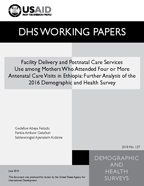- PUBLICATIONS
- JOURNAL ARTICLES
- ORDER PUBLICATIONS
Publications Summary
- Document Type
- Working Papers
- Publication Topic(s)
- Maternal Health
- Country(s)
- Ethiopia
- Language
- English
- Recommended Citation
- Fekadu, Gedefaw A., Fentie A. Getahun, and Seblewongiel A. Kidanie. 2018. Facility Delivery and Postnatal Care Services Use among Mothers Who Attended Four or More Antenatal Care Visits in Ethiopia: Further Analysis of the 2016 Demographic and Health Survey. DHS Working Paper No. 137. Rockville, Maryland, USA: ICF.
- Download Citation
- RIS format / Text format / Endnote format
- Publication Date
- June 2018
- Publication ID
- WP137
Download
 Facility Delivery and Postnatal Care Services Use among Mothers Who Attended Four or More Antenatal Care Visits in Ethiopia: Further Analysis of the 2016 Demographic and Health Survey (PDF, 722K)
Facility Delivery and Postnatal Care Services Use among Mothers Who Attended Four or More Antenatal Care Visits in Ethiopia: Further Analysis of the 2016 Demographic and Health Survey (PDF, 722K)
